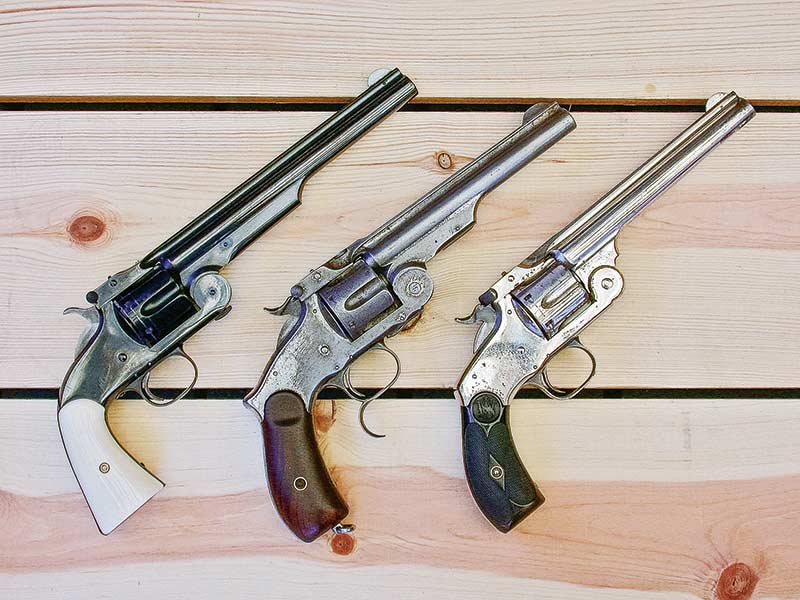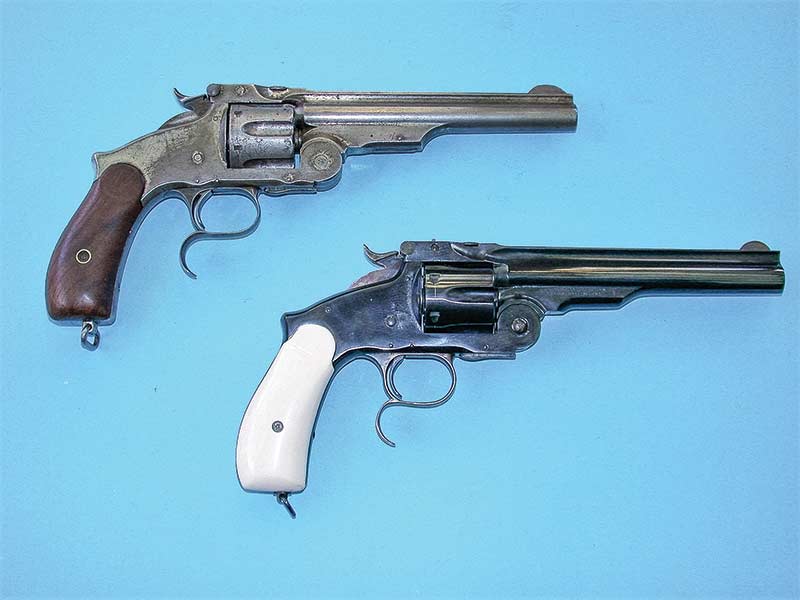THE .44 RUSSIAN
BORN IN THE USA, PERFECTED BY THE BEAR
WRITTEN BY JOHN TAFFIN
In 1870 the United States Military purchased 1,000 Smith & Wesson .44 American revolvers. However, they were not satisfied with this first cartridge-firing big-bore revolver and did not order any more. The Russians also ordered Smith & Wesson Americans and, as with the United States Military, were also not satisfied. However, instead of abandoning this new .44 sixgun they set about to improve it.
Russia Gets Involved
Smith & Wesson had originally sent a sample .44 American to the Russian Military Attaché, General Alexander Gorloff, who happened to be in Hartford purchasing rifles. This is one of the smartest things Smith & Wesson could have done as the first contract from Russia in May 1871 resulted in 20,000 of the Model #3 American going to Russia. Eventually over 130,000 were purchased by the Russians. However, they made two significant changes, one of which still impacts us today.
Changes
The original American had a rounded back strap. For better control, the Russians added a humpback back strap which allowed better control under recoil. They also added a spur on the trigger guard and to this day no one is sure why this was chosen. Some say it allowed the placing of the revolver in a sash around the waist and the trigger guard would prevent it from slipping. Others say it was chosen as a place to put the middle finger while shooting. I have tried this method and it really works in steadying the sixgun. The Russians also ask for internal changes to be made to improve the American.
However, the most far-reaching change had to do not with the sixgun itself but the ammunition. The .44 American used a heeled bullet with the smaller diameter placed inside the case and the bullet itself the same diameter as the case. This is what allows us to make .44 American brass out of .41 Magnum brass trimmed to length. The Russians wanted a bullet of uniform size and placed inside the brass. By keeping the bullet at the same basic diameter as the original .44, the brass case needed to be increased in diameter. This also allowed for proper crimping of the bullet to prevent it moving forward under recoil. The result was the same basic style of sixgun cartridge used today. To arrive at later .44 Cartridges, Smith & Wesson simply lengthened the .44 Russian brass.
An original Smith & Wesson Model #3 Russian (top) compared to a Uberti replica.
Models
The first Smith & Wesson .44 Americans purchased by the Russians are known as the 1st Model and basically are the same configuration as the original. With the 2nd Model we see the arrival of the spurred trigger guard and the hump-backed, round-butted grip frame. By the time the 3rd Model arrived it was known as the Model #3 Russian and was standardized at a 6-1/2″ barrel length.
Original Model #3 Russians were produced from 1874 to 1878 and may be tough to find in good shooting shape without commanding high collector dollars. However, Navy Arms offered an excellent shooting replica of the New Model Russian. The Navy Arms New Model Russian or Model #3 Russian is a faithful copy complete with very small sights of the original and is finished overall in a deep blue-black finish set off with a case colored hammer, trigger guard and locking latch. Stocks are smooth walnut as found on the originals.
The Model #3 Russian is also offered by Uberti. Both versions come with factory stocks of smooth European walnut, however my personal Navy Arms New Model Russian has been fitted with Ultra Ivory grips from Eagle Grips. Ultra Ivory, while a synthetic material, is very close to real ivory, with milky white color and ivory type grain and they also provide a good contrast to the dark blue finish of the New Model Russian.
New Model
After the Model #3 Russian the Smith & Wesson New Model #3 arrived and was a sixgun way ahead of its time. It is easily distinguished from the #3 Russian by the fact it does not have a spur on the trigger guard nor the prominent hump on the back strap. It is so precisely fitted it demands smokeless powder for perfect functioning. However all of the frames of these guns were built in the black powder era and should only be used with black powder. The machining and tolerances used in their manufacture were so precise they are easily fouled and work very sluggishly after very few rounds. The only answer is to keep them clean.
“The machining and tolerances used in their manufacture were so precise they are easily fouled and work very sluggishly after very few rounds. The only answer is to keep them clean.”
Beginning in 1881 shooters now had a real choice when it came to Smith & Wesson .44 Russians. The Double Action First Model would be manufactured from 1881 to 1913, approximately 53,500 of them, however as with the New Model #3 all frames were made in the black powder era and they should only be used with black powder loads.
Accurate
The .44 Russian black powder load had a great reputation for accuracy. I decided to find out if there really was a basis for this. I loaded 50 rounds of .44 Russian duplicating the original load as closely as I could. Starting with .44 Russian balloon head brass (the old-style that had a greater capacity than modern solid head brass), I used a 250-gr. round-nosed cast bullet from a Lyman mold, black powder and the one concession I made to modern times was a magnum pistol primer. My test gun was a Colt Bisley Model which had been restored by fitting it with a 7-1/2″ Colt .44 Special barrel and an old Christy .44 cylinder. At 25 yards all 50 rounds cut one ragged hole.
Today .44 Russian chambered sixguns are found in replica form at Cimarron Firearms not only in Smith & Wesson Model #3s but also in 1860 and 1851 Cartridge conversions. I have also added .44 Russian chambered cylinders to .44 Special and .44-40 Colt Single Actions as well as a Texas Longhorn Arms West Texas Flat-Top Target which also has cylinders in .44 Magnum, .44 Special and .44-40. Of course it is possible to fire .44 Russian rounds in both .44 Special and .44 Magnum cylinders, however I feel more connected with the old days when I have a properly chambered cylinder.



